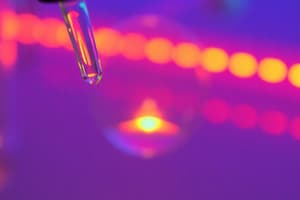Podcast
Questions and Answers
What does the process of anabolism refer to in a biochemical context?
What does the process of anabolism refer to in a biochemical context?
- The use of enzymes to break down carbohydrates.
- The synthesis of new, larger molecules. (correct)
- The degradation of complex molecules into simpler ones.
- The total of all metabolic reactions.
Which of the following lists the three major groups of organic molecules found in the body?
Which of the following lists the three major groups of organic molecules found in the body?
- Carbohydrates, lipids, and proteins. (correct)
- Carbohydrates, nucleic acids, and proteins.
- Sugars, lipids, and hormones.
- Lipids, proteins, and vitamins.
What is the primary purpose of using indicators in the identification of biomolecules?
What is the primary purpose of using indicators in the identification of biomolecules?
- To physically extract biomolecules from solutions.
- To chemically decompose the biomolecules.
- To filter out impurities from samples.
- To detect a change that indicates the presence of a chemical. (correct)
What is the correct ratio for diluting the stock solution of Lugol’s Iodine Solution to prepare the working solution?
What is the correct ratio for diluting the stock solution of Lugol’s Iodine Solution to prepare the working solution?
Which ingredient is NOT part of the preparation for Lugol’s Iodine Solution?
Which ingredient is NOT part of the preparation for Lugol’s Iodine Solution?
In the context of metabolism, what does the term catabolism refer to?
In the context of metabolism, what does the term catabolism refer to?
What is the role of 2,6-dichlorophenol-indophenol (DCPIP) in biochemical tests?
What is the role of 2,6-dichlorophenol-indophenol (DCPIP) in biochemical tests?
What is the term used to refer to all biochemical reactions occurring in the body?
What is the term used to refer to all biochemical reactions occurring in the body?
What does the formation of a milky or cloudy emulsion indicate when testing for fats?
What does the formation of a milky or cloudy emulsion indicate when testing for fats?
Why is a water-only sample included in each test conducted?
Why is a water-only sample included in each test conducted?
Which of the following could be a source of error that affects test results?
Which of the following could be a source of error that affects test results?
In microscopy, what does the term 'resolving power' refer to?
In microscopy, what does the term 'resolving power' refer to?
What is one method to prepare a specimen for viewing under a microscope?
What is one method to prepare a specimen for viewing under a microscope?
How can the total magnification of a microscope lens system be calculated?
How can the total magnification of a microscope lens system be calculated?
What is the significance of recognizing potential sources of error in experiments?
What is the significance of recognizing potential sources of error in experiments?
Which of the following cell types can generally be observed using a light microscope?
Which of the following cell types can generally be observed using a light microscope?
What is a key characteristic that distinguishes prokaryotic cells from eukaryotic cells?
What is a key characteristic that distinguishes prokaryotic cells from eukaryotic cells?
Which structure is present in plant cells but absent in animal cells?
Which structure is present in plant cells but absent in animal cells?
Which of the following is primarily responsible for protein synthesis in both prokaryotic and eukaryotic cells?
Which of the following is primarily responsible for protein synthesis in both prokaryotic and eukaryotic cells?
What function does the large central vacuole serve in plant cells?
What function does the large central vacuole serve in plant cells?
Which organelle is responsible for housing the DNA in eukaryotic cells?
Which organelle is responsible for housing the DNA in eukaryotic cells?
What is the primary role of the cell wall in prokaryotic and plant cells?
What is the primary role of the cell wall in prokaryotic and plant cells?
Which domain includes organisms with prokaryotic cells?
Which domain includes organisms with prokaryotic cells?
Which of the following structures is involved in the production and storage of food in plant cells?
Which of the following structures is involved in the production and storage of food in plant cells?
What is the function of the condenser located beneath the stage?
What is the function of the condenser located beneath the stage?
Which adjustment knob should be used exclusively with low power objectives (4X, 10X)?
Which adjustment knob should be used exclusively with low power objectives (4X, 10X)?
What should you do before using a microscope?
What should you do before using a microscope?
What action is prohibited when focusing under the 40X or 100X objective?
What action is prohibited when focusing under the 40X or 100X objective?
What must be done to the condenser before turning on the lamp?
What must be done to the condenser before turning on the lamp?
When using the microscope, how should the slide be placed on the stage?
When using the microscope, how should the slide be placed on the stage?
Which part of the microscope is responsible for holding objective lenses?
Which part of the microscope is responsible for holding objective lenses?
What is the correct procedure for cleaning the objective lenses of the microscope?
What is the correct procedure for cleaning the objective lenses of the microscope?
What is the main purpose of a spectrophotometer?
What is the main purpose of a spectrophotometer?
Which part of the spectrophotometer is responsible for emitting light?
Which part of the spectrophotometer is responsible for emitting light?
What role does the monochromator play in a spectrophotometer?
What role does the monochromator play in a spectrophotometer?
Which of the following materials is typically used for the cuvette in a spectrophotometer?
Which of the following materials is typically used for the cuvette in a spectrophotometer?
What does the detector in a spectrophotometer do?
What does the detector in a spectrophotometer do?
How does a spectrophotometer generally operate?
How does a spectrophotometer generally operate?
Why must the materials of the cuvette be transparent to the measured wavelength?
Why must the materials of the cuvette be transparent to the measured wavelength?
In which fields is a spectrophotometer predominantly used?
In which fields is a spectrophotometer predominantly used?
Flashcards are hidden until you start studying
Study Notes
Spectrophotometer
- A spectrophotometer is an instrument used to measure the intensity of light as a function of its wavelength.
- It measures how much a chemical substance absorbs light by measuring the intensity of light passing through a solution.
- The device provides information about the molecular composition and concentration of substances in a sample.
- It is used in fields like chemistry, biology, and industrial applications.
Parts of the Spectrophotometer
- Light Source: Emits a continuous spectrum of light, like tungsten lamps for visible light and deuterium lamps for UV light.
- Monochromator: Disperses the light into its component wavelengths and selects a specific wavelength to pass through the sample. It can be a diffraction grating or prism.
- Sample Holder (Cuvette): A transparent container that holds the liquid sample. The material of the cuvette (quartz or glass) must be transparent to the wavelength being measured.
- Detector: Detects the light after it passes through the sample and converts it into an electrical signal proportional to the light intensity. Examples include photodiodes or photomultiplier tubes.
- Display/Output: Shows the measurement results, either as a digital readout or connected to a computer for data processing and analysis.
How a Spectrophotometer works
- Light from the source is directed through a monochromator, isolating a specific wavelength.
- This monochromatic light passes through the sample in the cuvette.
- Some of the light is absorbed by the sample, while the rest passes through.
- The detector measures the intensity of the light that passes through the sample.
- The spectrophotometer compares the intensity of the light that passes through the sample to the intensity of the light that passes through a blank.
- This comparison allows for the determination of the amount of light absorbed by the sample.
- The amount of light absorbed is directly proportional to the concentration of the substance in the sample.
- A spectrophotometer can be used to identify and quantify various compounds.
Studying That Suits You
Use AI to generate personalized quizzes and flashcards to suit your learning preferences.



